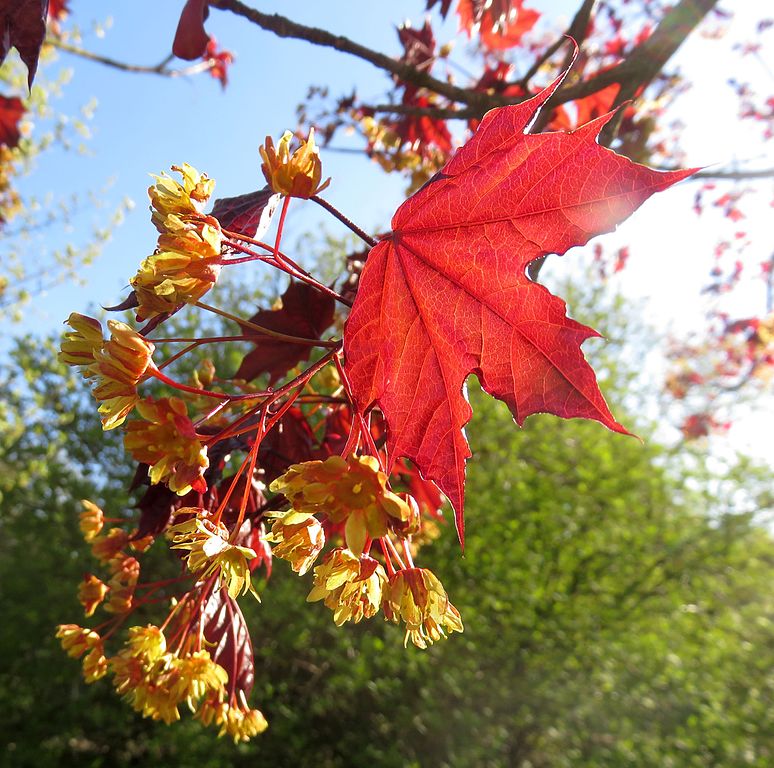This is the fifth part of a series on Norway maple cultivars.
Introduction
Norway maple is one of the most common trees in North America. It has an extended history on the continent, having been introduced as an ornamental plant to the United States in the early 20th century. While Norway maple is classified in several states as invasive, numerous cultivars have been derived from it over the past few decades. The following examines some of the most notable Norway maple varieties, including ‘Olmsted’, ‘Royal Red’, and ‘Schwedleri’.
‘Olmsted’ is a medium sized cultivar that grows 30 to 45 feet, with a narrow 15 to 20 foot spread. It develops at a medium to fast rate. It establishes an upright growth habit, and forms a dense crown. In early spring, greenish-yellow flowers blanket the branches. These give way to samaras in summer. Lobed, star-shaped leaves display a dark green color through spring and summer. In fall, they turn a resplendent golden yellow. The shallow root system allows ‘Olmsted’ to easily compete with lawn grasses and weeds. ‘Olmsted’ may be planted in a variety of soil types. Its slender frame makes it ideal for planting along roadways. It is tolerant of air pollution, salt spraying, and drought conditions. ‘Olmsted’ should be planted in sites exposed to full sunlight. Birds and rodents feed on the seeds produced by ‘Olmsted’.
‘Royal Red’ is the hardiest cultivar of Norway maple. It is a medium sized variety, reaching heights of 30 to 40 feet, with a 25 to 35 foot spread. It grows at a medium rate. ‘Royal Red’ is derived from the renown ‘Crimson King’ variety, and shares many of the same traits. Greenish-yellow corymbs form along the branches of ‘Royal Red’ in early spring, just prior to budburst. These are followed by samaras, which cling to the brances in summer. The lobed, star-shaped leaves form in spring. They feature an attractive purple to maroon shade throughout the growing season. This hue deepens in fall, before turning bronze. The leaves are shed shortly thereafter. ‘Royal Red’ has a shallow root system that often out-competes other plants, including lawn grasses and weeds. It is adaptable to a bevy of soil types, but requires full sunlight to reach its full potential. ‘Royal Red’ is less prone to trunk cracking than other Norway maple cultivars. It is tolerant of drought conditions, salt spraying, and pollution. The seeds are a source of food for birds and rodents.
‘Schwedleri’ – This cultivar of Norway maple is a medium to large sized tree. It typically reaches heights of 40 to 60 feet, with a 35 to 50 foot spread, but may grow taller when planted in a restrictive space. It grows at a medium rate, and assumes an ovate to rounded form. It has a dense crown once mature. As the tree ages, its branches droop toward the ground. The branches are covered in greenish-yellow corymbs in spring. The corymbs are replaced by samaras by summer. The foliage is a reddish-bronze color in spring, but turns green in summer. The leaves are simple, lobed, and star-shaped. A shallow root system allows ‘Schwedleri’ to easily compete with lawn grasses and weeds. ‘Schwedleri’ is vulnerable to heat scorching in summer. Full sunlight is required for ‘Schwedleri’ to thrive. Birds and rodents feed on the seeds produced by ‘Schewedleri’.
If you have any questions about Norway maple, or you are interested in one of our tree services, contact us at 978-468-6688, or Sales@IronTreeService.com. We are available 24/7, and can accommodate any schedule. All estimates are free of charge. We look forward to hearing from you.
Photo courtesy of Alex Hauner CC-by-4.0


